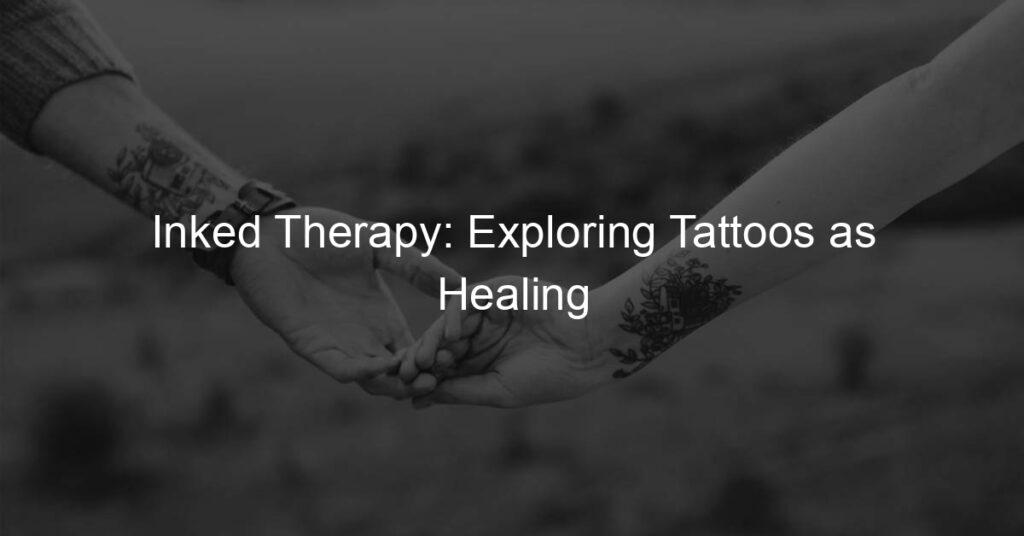
Introduction: The Therapeutic Power of Ink
For centuries, tattoos have been used as a form of self-expression, a symbol of belonging, and a mark of personal journeys. However, in recent years, a new perspective on tattoos has emerged. They are now seen as a powerful tool for healing and wellness. This is the world of Ink Therapy.
- Understanding the concept of Ink Therapy
- Exploring the connection between Tattoos and Wellness
Ink Therapy, also known as Tattoo Therapy, is a therapeutic process that uses the art of tattooing as a means to heal. It is not just about getting a tattoo; it’s about the transformative journey that comes with it. The process involves carefully choosing a design that symbolizes a person’s healing or growth, and the act of tattooing serves as a form of catharsis, allowing individuals to express their emotions, experiences, and healing process in a unique and personal way.
So, how exactly do tattoos contribute to wellness? The answer lies in the psychological and emotional benefits that tattoos can provide. Tattoos can serve as a constant reminder of one’s strength and resilience, helping to boost self-esteem and confidence. They can also symbolize a significant life event or change, helping individuals process their experiences and emotions. In many cases, tattoos can even help individuals cope with trauma or loss, providing a tangible symbol of healing and recovery.
In the following sections, we will delve deeper into the history of therapeutic tattoos, understand the science behind Ink Therapy, explore real-life case studies, and highlight the key takeaways of this fascinating form of therapy. So, whether you’re considering getting a tattoo for therapeutic reasons, or simply curious about the concept, read on to discover the healing power of tattoos.
The History of Therapeutic Tattoos
Therapeutic tattoos have a rich and fascinating history that dates back thousands of years. They have been used in various cultures for healing, protection, and spiritual purposes. Let’s delve into the origins and cultural significance of these healing tattoos and how they have evolved over the centuries.
- Origins and Cultural Significance of Healing Tattoos
- Evolution of Tattoos as Therapy Over the Centuries
The practice of therapeutic tattooing can be traced back to ancient civilizations. In Egypt, tattoos were used as a form of therapy to cure diseases and protect the wearer. In traditional Maori culture, tattoos or ‘Ta Moko’ were not only a form of body art but also a method of healing and protection.
Healing tattoos were often placed on specific parts of the body that were believed to be connected to certain health problems. For instance, a tattoo on the lower back might be used to alleviate pain or discomfort in that area. These tattoos were not just symbols; they were a vital part of the healing process.
Over the centuries, the use of tattoos for therapeutic purposes has evolved and adapted to the changing times. In the Middle Ages, tattoos were used as a form of amulet to ward off evil spirits and diseases. In the 19th century, tattoos became a popular form of self-expression among sailors and soldiers, who believed that certain symbols could protect them in battle.
In the modern era, therapeutic tattoos have taken on new forms and meanings. Today, they are often used as a form of psychotherapy, helping individuals to cope with trauma, loss, or mental health issues. They serve as a permanent reminder of the wearer’s resilience and strength, aiding in their healing process.
In conclusion, therapeutic tattoos have a long and diverse history. From ancient healing practices to modern psychotherapy, they have served as a powerful tool for healing and protection. As we continue to understand and appreciate the therapeutic power of ink, we can look forward to new and innovative uses for this ancient art form.
Understanding Tattoo Therapy
As we delve deeper into the world of therapeutic tattoos, it’s important to understand the concept of Tattoo Therapy. This unique approach to healing has been gaining popularity in recent years, and for good reason.
What is Tattoo Therapy?
Tattoo Therapy is a fascinating blend of art and healing. But what exactly does it entail? Let’s break it down.
- Defining Tattoo Therapy
- How Tattoo Therapy works
Tattoo Therapy is a therapeutic process that involves getting a tattoo with the purpose of healing or coping with emotional, mental, or physical pain. It’s not just about getting a beautiful piece of art on your body, but also about the therapeutic journey that comes with it. The tattoo serves as a constant reminder of strength, resilience, and the ability to overcome challenges.
Tattoo Therapy works by allowing individuals to express their feelings, experiences, or struggles through the medium of body art. The process of getting a tattoo can be cathartic, allowing individuals to release pent-up emotions. The finished tattoo serves as a symbol of their journey, a testament to their strength, and a constant reminder of their resilience. It’s important to note that Tattoo Therapy should be used as a complement to traditional therapy methods, not as a substitute.
In summary, Tattoo Therapy is a unique form of self-expression that can aid in the healing process. It’s a journey that intertwines art and healing, allowing individuals to tell their stories, commemorate their struggles, and celebrate their victories.
Types of Therapeutic Tattoos
Therapeutic tattoos are not just a form of self-expression, but they also serve as a powerful tool for healing and recovery. They come in different types, each with its unique purpose and significance. Let’s explore the three main types of therapeutic tattoos.
-
Mental Health Tattoos
Mental health tattoos are often used as a symbol of resilience and recovery. They serve as a constant reminder of the battles one has overcome and the strength they possess. For instance, the semicolon tattoo has become a popular symbol of mental health awareness. It represents the idea that the wearer’s story is not over, mirroring the punctuation’s use in literature.
-
Emotional Healing Tattoos
Emotional healing tattoos often commemorate personal growth or a significant life event. They can symbolize the process of healing from a traumatic experience or the loss of a loved one. These tattoos can serve as a form of closure and a step towards healing. An example could be a tattoo of a phoenix, a mythical bird that rises from its ashes, symbolizing rebirth and renewal after a difficult period.
-
Tattoos for Physical Healing
Tattoos for physical healing are typically used to cover scars or marks from surgeries or injuries. They can help individuals regain confidence in their bodies and celebrate their recovery. For example, many breast cancer survivors choose to get a tattoo over their mastectomy scars as a symbol of their victory over the disease.
Regardless of the type, therapeutic tattoos can provide a sense of empowerment and control over one’s body and mind. They are a testament to the wearer’s journey, their struggles, and their triumphs. Remember, the meaning behind a tattoo is deeply personal and unique to the wearer.
The Science Behind Ink Therapy
When we talk about tattoos, we often think about the art and personal expression they represent. But did you know there’s a whole science behind how tattoos can be therapeutic? Let’s dive into the fascinating world of ink therapy and explore the psychological and physiological benefits it offers.
- Psychological benefits of Tattoos as Therapy
- Physiological impact of Therapeutic Tattoos
Tattoos can serve as a powerful tool for therapy due to their psychological benefits. They can help individuals express their feelings and experiences in a way that words sometimes can’t. This form of self-expression can lead to improved self-esteem and a stronger sense of identity.
For example, people who have gone through significant life changes or trauma often use tattoos as a form of catharsis. They serve as a permanent reminder of their resilience and strength. In fact, a study conducted by the American Journal of Human Biology found that tattoos can help reduce feelings of guilt and shame, and promote self-forgiveness.
But it’s not just the psychological aspect that makes tattoos therapeutic. There’s a physiological side to it too. The process of getting a tattoo involves the release of endorphins, the body’s natural painkillers. This can create a sense of euphoria and relief, similar to the ‘runner’s high’ experienced by athletes.
Furthermore, the act of enduring the pain of getting a tattoo can be a form of exposure therapy, helping individuals confront and manage their fear of pain. This can lead to improved pain tolerance and management skills.
In conclusion, the science behind ink therapy is a fascinating blend of psychology and physiology. Whether it’s through self-expression, catharsis, or pain management, tattoos can offer significant therapeutic benefits. So next time you see a tattoo, remember – it’s not just art, it’s therapy.
Case Studies: Tattoos for Healing
In this section, we will explore real-life examples of how tattoos have been used as a form of therapy to help individuals overcome personal trauma. These case studies highlight the transformative power of ink therapy.
Case Study 1: Using Tattoos to Overcome Trauma
Let’s delve into our first case study, which involves a person who used tattoo therapy to deal with a traumatic experience.
- Background of the case: Our subject is a 30-year-old woman named Sarah. She experienced a traumatic car accident that left her with significant scarring. The scars were not just physical; they were emotional reminders of the terrifying event. Sarah felt self-conscious and found it hard to move forward.
- Process and outcome of the Tattoo Therapy: Sarah decided to transform her scars into a piece of art. She worked with a skilled tattoo artist who specialized in scar cover-up tattoos. The process was therapeutic for Sarah, allowing her to reclaim control over her body and her narrative. The tattoo, a beautiful floral design, gave her a new perspective on her scars. Instead of seeing them as a reminder of the accident, they became a symbol of her resilience and survival. Sarah reported feeling more confident and was able to let go of some of the emotional pain tied to her trauma.
This case study demonstrates how tattoos can serve as a powerful tool for healing and personal transformation. In the next section, we will explore another case where tattoos were used as a form of self-expression and healing.
Case Study 2: Tattoos as a Form of Self-Expression and Healing
Let’s delve into a fascinating case study that beautifully illustrates the therapeutic power of tattoos. This case revolves around a woman named Lisa, who used tattoos as a form of self-expression and healing.
- Background of the case
- Process and outcome of the Tattoo Therapy
Lisa, a 35-year-old woman, had been struggling with depression and anxiety for many years. She felt trapped in her own body and mind, unable to express her feelings and emotions. Lisa felt like she was wearing a mask, hiding her true self from the world. One day, she came across an article about tattoo therapy and decided to give it a try.
Lisa met with a professional tattoo artist who was also trained in therapeutic tattooing. They discussed her feelings, emotions, and what she wanted to express through her tattoo. The artist then created a unique design that represented Lisa’s journey towards healing.
The process of getting the tattoo was therapeutic for Lisa. She felt a sense of release and relief as the tattoo needle etched her story onto her skin. The pain of the tattooing process was symbolic of the emotional pain she had been carrying for so long.
After the tattoo was completed, Lisa felt a profound sense of peace and acceptance. She felt like she had finally been able to express her inner turmoil in a visible and tangible way. The tattoo served as a constant reminder of her journey and her strength. It also sparked conversations with others, allowing her to share her story and raise awareness about mental health.
In conclusion, this case study demonstrates the potential of tattoos as a form of self-expression and healing. It shows how tattoos can help individuals express their emotions, tell their stories, and embark on a journey towards healing.
Key Takeaways: The Healing Power of Tattoos
In this blog post, we have explored the fascinating world of therapeutic tattoos. Let’s summarize the key points we’ve learned:
- Understanding the therapeutic potential of tattoos
- Recognizing the emotional and mental benefits of Tattoo Therapy
- Appreciating the cultural and personal significance of Healing Tattoos
Tattoos have been used for centuries as a form of expression and identity. Today, they are also recognized for their therapeutic potential. Tattoo therapy can help individuals cope with trauma, loss, and mental health issues. The act of getting a tattoo can be a cathartic experience, allowing individuals to reclaim control over their bodies and express their feelings in a unique, visual way.
Tattoo therapy can offer emotional and mental benefits. It can serve as a form of self-care, providing a sense of accomplishment and a boost in self-esteem. Tattoos can also serve as a permanent reminder of personal growth and resilience. They can symbolize the overcoming of obstacles, the celebration of milestones, or the honoring of loved ones.
Healing tattoos hold deep cultural and personal significance. In many cultures, tattoos are seen as a rite of passage or a symbol of status and belonging. In the context of healing, tattoos can represent a personal journey, a triumph over adversity, or a tribute to a loved one. They can tell a story, commemorate an event, or express a personal philosophy or belief.
In conclusion, tattoos are not just a form of body art. They can be powerful tools for healing, self-expression, and personal growth. Whether you are considering getting a tattoo for therapeutic reasons or simply appreciate the art form, understanding the healing power of tattoos can deepen your appreciation and respect for this ancient practice.
Conclusion: Embracing Tattoos as Instruments of Healing
As we draw to a close, it’s essential to revisit the key points we’ve discussed and look towards the future of tattoos as a form of therapy. Tattoos have been used for centuries as a form of expression and identity, but their potential as healing tools is only now being fully recognized and embraced.
- Revisiting the concept of Ink Therapy
Throughout this article, we’ve delved into the concept of Ink Therapy, a therapeutic process that uses the art of tattooing as a means to heal. The process involves transforming physical or emotional scars into beautiful works of art, allowing individuals to reclaim their bodies and find closure from traumatic experiences.
Scientific studies have shown that getting a tattoo can release endorphins, the body’s natural painkillers, which can help individuals cope with physical pain or emotional distress. Furthermore, the act of choosing a design and placement for a tattoo can give individuals a sense of control and empowerment, contributing to their mental well-being.
- Future prospects of Tattoos as Therapy
As we look towards the future, the potential for tattoos as a form of therapy is immense. With more research and understanding, there is a possibility that this form of therapy could be integrated into mainstream mental health and physical recovery programs.
Moreover, the growing acceptance and de-stigmatization of tattoos in society are likely to open up more opportunities for individuals to explore this form of therapy without fear of judgment or discrimination. The future of tattoos as therapy is bright, and it’s a journey we’re excited to watch unfold.
In conclusion, tattoos are not just body art; they are powerful tools of healing and transformation. They are a testament to human resilience and the ability to turn pain into beauty. As we embrace tattoos as instruments of healing, we open up a new world of therapeutic possibilities.






